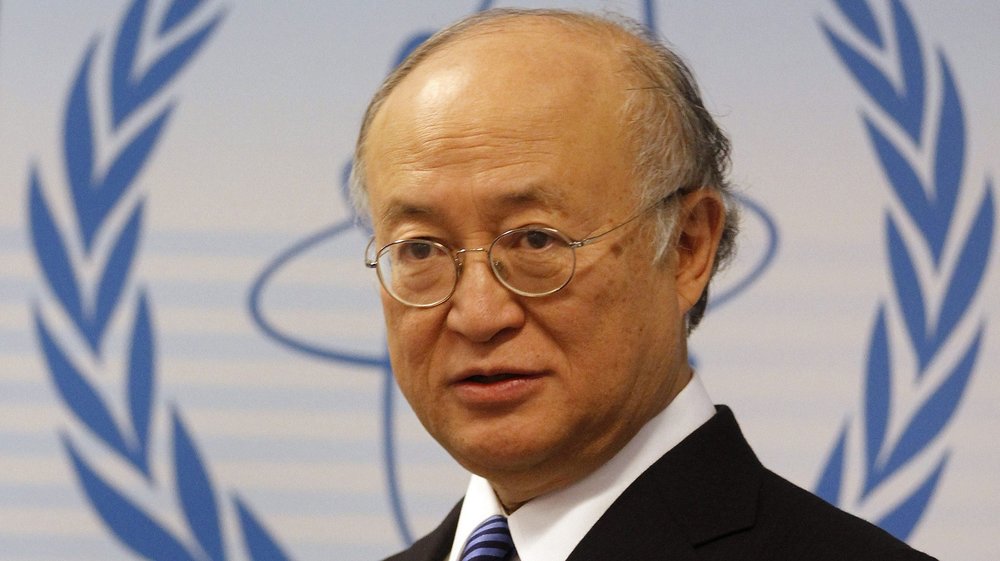What Message Does Amano Have for Iran?

TEHRAN _ Yukio Amano, Director General of the International Atomic Energy Agency, is scheduled to travel to Iran. This trip will take place on Saturday, October 28th. On this trip, Amano will meet with officials in our country, including the head of the Atomic Energy Agency. There are some points about Amano's trip to Iran that need to be addressed:
First, Amano's visit happens in a situation that the United States has pressed the IAEA in recent months on issues such as inspections of Iranian military sites. The United States Representative Nikki Haley met with Amano in her visit to Vienna shortly before.
The problem is that Trump, on the suggestion of some dependent think tanks, has decided to insert the subject of inspecting Iran's military sites into the content of the nuclear deal, insisting on Section T of the Annex 1 in the first nuclear agreement. This is despite the fact that Islamic Republic of Iran has repeatedly stated that it will not allow the inspection of its military sites due to the need to protect the country's military secrets (which is the absolute right of each country).
On the eve of his trip to Iran, Amano has referred to some points on the nuclear deal between Iran and members of the P1 + 5 in a meeting with the French Foreign Minister. The IAEA Director General stresses that the IAEA will continue to carry out an inspection of Iran's nuclear sites without any problem.
At the end of his meeting with French Foreign Minister Jean-Yves Le Drian in Paris, Amano said he had not noticed any changes in Iran's approach regarding the nuclear deal. He argued that Iranians were really cautious following the decision by President Donald Trump to disapprove Iran's commitment to the nuclear deal.
Amano also stressed that Iran fulfilled its nuclear obligations under the Joint Comprehensive Plan of Plan. While Washington is seeking to expand inspections from Iran's nuclear sites, the IAEA Director General emphasized: "We were able to enter places that we had to visit."
The fact is that Amano has repeatedly emphasized that there is no distinction between nuclear and military sites in the IAEA inspections. One of the topics that Trump focuses on is inspecting Iran's military sites under the pretext of verifying Iran's nuclear program. As noted above, in this regard, there's a clause in the content of the JCPOA called the Section T of Annex 1.
Here we need to have a review on Section T of the nuclear deal. According to this Section, "Iran will not engage in the following activities which could contribute to the development of a nuclear explosive device". According to the JCPOA, these activities include:
Designing, developing, fabricating, acquiring, or using multi-point explosive detonation systems suitable for a nuclear explosive device, unless approved by the Joint Commission for non-nuclear purposes and subject to monitoring.
Designing, developing, fabricating, acquiring, or using explosive diagnostic systems (streak cameras, framing cameras and flash x-ray cameras) suitable for the development of a nuclear explosive device, unless approved by the Joint Commission for non-nuclear purposes and subject to monitoring.
The Director General of the IAEA has stated that the interpretation of this section and the manner in which the IAEA is pursuing verification of this paragraph is difference between Iran and Russia on the one hand and other members of the P1 + 5 on the other hand. However, the main question about Amano's position on this disputed section is still strong: Why did the IAEA Director General, after 2 years of concluding the JCPOA, and after the visit of Nikki Haley to Vienna, has now remembered this controversial section? On the other hand, as the IAEA officials acknowledge, this Agency doesn't have the right to inspect Iran's military sites for verifying the Section T of Annex 1.
The Russian Foreign Minister Sergei Lavrov has recently emphasized that, according to Section T of the Annex 1 of the agreement, the Agency has no discretion to inspect Iranian military sites. In such circumstances, what does the emphasis of the Agency's officials on reinterpretation of this Section mean? In recent weeks, Amano has repeatedly raised the issue of inspecting Iran's military sites and the IAEA's authority on the pretext of ambiguity in the relevant Section. That's what people like Trump and Nikki Haley have been asking the IAEA's Director General.
Undoubtedly, Amano's main goal from his visit to Iran and meeting with our country's authorities, is to seek Trump's end in inspecting our country's military sites (under the pretext of revising Section T of the Annex 1). Undoubtedly, in this regard, our country's authorities should continue to emphasize their positions on the prohibition of any inspection of Iranian military sites. Obviously, the Agency does not have the right to access the military sites of any country under any pretext, including verification of the nuclear program of a country. This rule applies to Iran as well.
In recent years, Amano has generally taken dual and non-transparent positions about the points of disagreement between Iran and the Western members of P1 +5. It is not without reason that Amano is referred to as the Graymanof the Agency. Unfortunately, one of the main concerns of Amano is to provide U.S. goals against other members of the Agency. Therefore, the positions of the Islamic Republic of Iran should be transferred to Amano in a straightforward manner. In other words, our experience has shown that the Agency can't be regarded as a trustable institution in Western-Iranian relations.
Leave a Comment